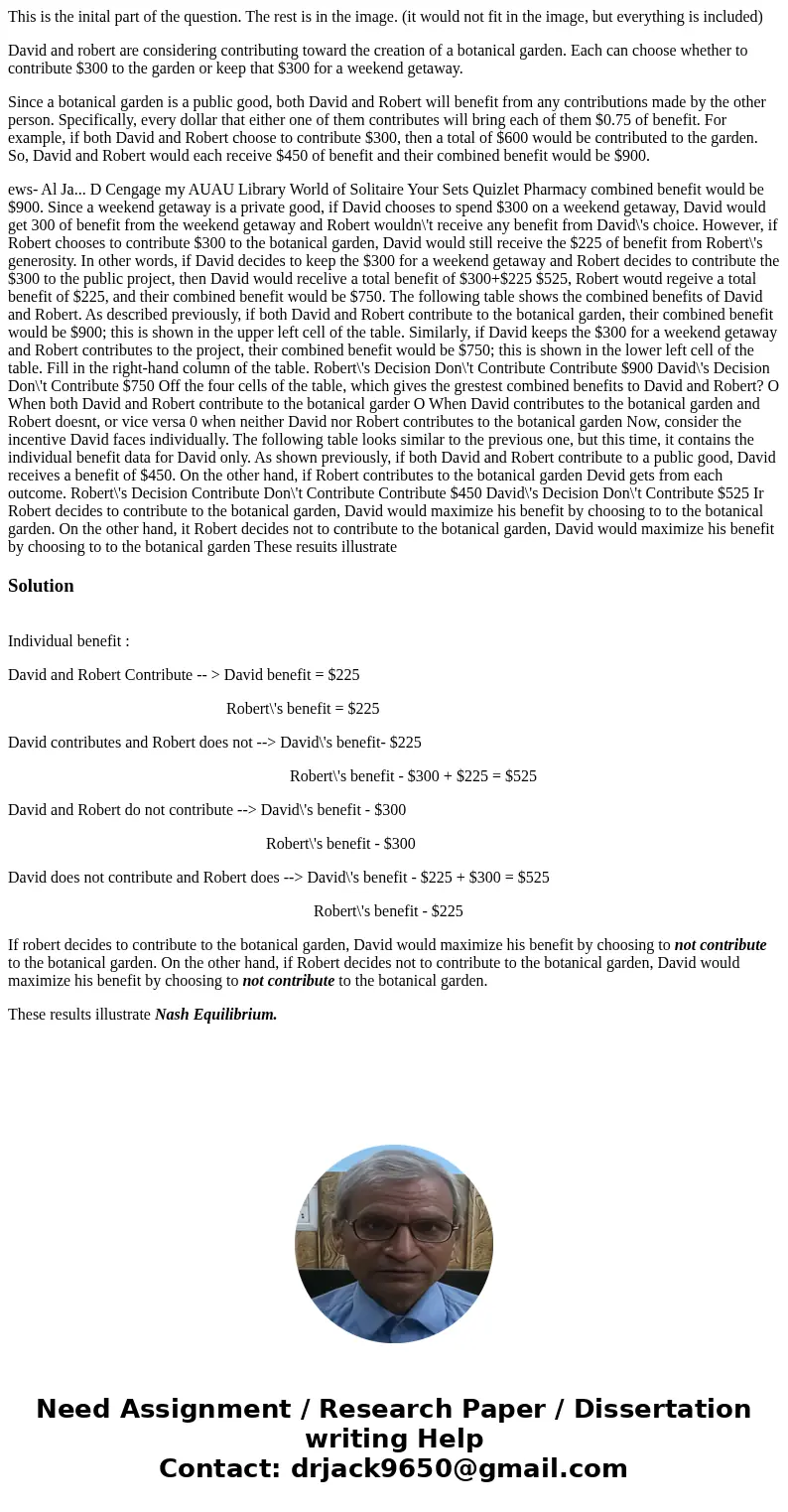This is the inital part of the question The rest is in the i
This is the inital part of the question. The rest is in the image. (it would not fit in the image, but everything is included)
David and robert are considering contributing toward the creation of a botanical garden. Each can choose whether to contribute $300 to the garden or keep that $300 for a weekend getaway.
Since a botanical garden is a public good, both David and Robert will benefit from any contributions made by the other person. Specifically, every dollar that either one of them contributes will bring each of them $0.75 of benefit. For example, if both David and Robert choose to contribute $300, then a total of $600 would be contributed to the garden. So, David and Robert would each receive $450 of benefit and their combined benefit would be $900.
ews- Al Ja... D Cengage my AUAU Library World of Solitaire Your Sets Quizlet Pharmacy combined benefit would be $900. Since a weekend getaway is a private good, if David chooses to spend $300 on a weekend getaway, David would get 300 of benefit from the weekend getaway and Robert wouldn\'t receive any benefit from David\'s choice. However, if Robert chooses to contribute $300 to the botanical garden, David would still receive the $225 of benefit from Robert\'s generosity. In other words, if David decides to keep the $300 for a weekend getaway and Robert decides to contribute the $300 to the public project, then David would recelive a total benefit of $300+$225 $525, Robert woutd regeive a total benefit of $225, and their combined benefit would be $750. The following table shows the combined benefits of David and Robert. As described previously, if both David and Robert contribute to the botanical garden, their combined benefit would be $900; this is shown in the upper left cell of the table. Similarly, if David keeps the $300 for a weekend getaway and Robert contributes to the project, their combined benefit would be $750; this is shown in the lower left cell of the table. Fill in the right-hand column of the table. Robert\'s Decision Don\'t Contribute Contribute $900 David\'s Decision Don\'t Contribute $750 Off the four cells of the table, which gives the grestest combined benefits to David and Robert? O When both David and Robert contribute to the botanical garder O When David contributes to the botanical garden and Robert doesnt, or vice versa 0 when neither David nor Robert contributes to the botanical garden Now, consider the incentive David faces individually. The following table looks similar to the previous one, but this time, it contains the individual benefit data for David only. As shown previously, if both David and Robert contribute to a public good, David receives a benefit of $450. On the other hand, if Robert contributes to the botanical garden Devid gets from each outcome. Robert\'s Decision Contribute Don\'t Contribute Contribute $450 David\'s Decision Don\'t Contribute $525 Ir Robert decides to contribute to the botanical garden, David would maximize his benefit by choosing to to the botanical garden. On the other hand, it Robert decides not to contribute to the botanical garden, David would maximize his benefit by choosing to to the botanical garden These resuits illustrateSolution
Individual benefit :
David and Robert Contribute -- > David benefit = $225
Robert\'s benefit = $225
David contributes and Robert does not --> David\'s benefit- $225
Robert\'s benefit - $300 + $225 = $525
David and Robert do not contribute --> David\'s benefit - $300
Robert\'s benefit - $300
David does not contribute and Robert does --> David\'s benefit - $225 + $300 = $525
Robert\'s benefit - $225
If robert decides to contribute to the botanical garden, David would maximize his benefit by choosing to not contribute to the botanical garden. On the other hand, if Robert decides not to contribute to the botanical garden, David would maximize his benefit by choosing to not contribute to the botanical garden.
These results illustrate Nash Equilibrium.

 Homework Sourse
Homework Sourse